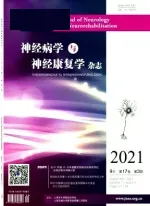国际抗癫联盟经修订的癫名词及概念:分类和名词委员会报告(下)
2010-04-27陆钦池李静波
陆钦池, 李静波, 孙 哲, 译
(上海交通大学医学院附属仁济医院神经内科,上海 200127)
注意在提到综合征时,局灶性和全面性这一二分法将被取消,即“局灶性或全面性癫”,取而代之的是癫将依据病因,并进一步由全面性或局灶性癫发作的特点进行描述,这是区分开病理生理表现的方法。
Ⅲ病因名称
特发性、症状性和隐源性这些名词有多重含义与内涵,有时会将多重概念混为一谈,这导致了大量的矛盾和混乱。该委员会已取消了这三个名词,并重新界定了基本病因的组别。以下三组病因是已被认可的:
1.遗传性
2.结构 /代谢性
表3 电—临床综合征和其他类型癫综合征

表3 电—临床综合征和其他类型癫综合征
?
3.“原因不明的”
原因不明就意味着中立,并指出根本原因的性质尚不清楚,遗传缺陷可能是它的核心,它也可能是一种尚未认识的独立的疾病或情况的结果。归类于“原因不明的”综合征的例子包括婴儿游走性部分性发作和婴儿肌阵挛性癫(原良性婴儿肌阵挛性癫(Engel J,2006))。现在将一些传统的“特发性”电临床综合征也归于这一类是合理的,这些综合征包括良性外侧裂性癫(Vadlamudi L etal.,2006)和儿童良性枕叶癫的早发型和Gastaut型(Taylor Iet al.,2008)。遗传因素可能包含在这些综合征中,但是目前的证据(兄弟姐妹中低的或无一致性)表明,遗传因素并不是最重要的。
某些电临床综合征,如儿童痉挛症,可有多种病因,在描述一般综合征时,具体病因应根据病人具体分析。
除了传统的标准和特点外,根据大量其他的详细情况每一种综合征和每一个病人可以被特征化。这些情况往往是病人评估的常规部分,也是区分公认的综合征的必要特征,包括认知和先前的发育情况、运动和感觉检查、EEG特征、诱因、发作类型与睡眠的关系。此外,现在有两类传统的综合征仍常用—“特发性全面性癫综合征”,“特发性部分性癫综合征”。这两组的意义和有效性在不久的将来可能被支持也可能最终被否决。在这种场合中使用“特发性”这个词是过时和退化的,正如今天世界上大部分地区仍用“to dial”来表示拨电话号码。
诊断一个人有脑病病程需要证明其没有发育到其同龄人所期望的水平,或者在能力上有退化。特别注意的是一个有脑病病程的人并不一定有“癫性脑病”的癫综合征。
2.“良性”
正如“特发性”这个术语一样,“良性”将不同的特点混合在一起,其中个别特点可能是其他非良性癫的特点。因此,我们建议我们去识别构成良性这个概念的不同特点,并把这些特点具体的固定的用到个别的癫类型中,而不是把一组综合征命名为良性。既然可预料的自发性缓解是一个理想的特点,应当将其定义为“自限性”电 -临床综合征,也就是说电 -临床综合征有很大或中度的可能性在预期的年龄发生自发性缓解。
在考虑个体患者与所描述和划分的综合征之间的不同时,这种方法的好处变得日益明显。一个综合征有许多方面的特点。如果我们知道了一个病人的综合征诊断,我们就知道了这个病人癫方面的大量信息,如可能的发病年龄,EEG模式,可能的药物反应性,认知和发育状况等等。我们能够从划分这些综合征的标准中得到相应的信息。那些还没被划分为明确的电 -临床综合征并伴有结构 -代谢原因的癫,最正常和合理的基本方法是根据特殊的潜在原因和病变进行划分或分类。对那些原因未知的以发作起始类型为主要特点的癫来说,目前还没有一个自然的分类方便有效地把他们分成更为同质的组别。修订后的推荐方法明确地回答了这个问题。把这些有一部分或极少特点的癫勉强归入一个和它们并不完全相符的分类系统,表明它们具有了超出我们知道的内容,这就阻碍了学科的进展。在门诊和临床研究中,我们应该投入更多的精力从这一系列方面去足够详细的描述个体患者,通过这种方法来促进对以前尚未了解的综合征分类的客观研究。这些信息然后也可以用来作为客观分析的基础,从而发现潜在的新的“综合征”(Berg and Blackstone,2006)。这也会极大地促进计划的诊断手册的使用。手册可以作为一个指导,其内有明确的定义和案例,这些可以帮助临床医生在确定或排除某种诊断时对病人进行必要的观察。
Berg AT,Blackstone NW.Concepts in classification and their relevance to epilepsy[J].Epilepsy Res,2006,70:11-19.
BlumeW,Lüders H,Mizrahi E,et al.International League Against Epilepsy,2005.
Capovilla G,Berg AT,Cross JH,et al.Conceptualdichotom ies in classifying epilepsies:partial versus generalized and idiopathic versus symptomatic(April 18-20th,2008,Monreale,Italy)[J].Epilepsia,2009,50:1645-1649.
Proposal for revised clinical and electrographic classification of epileptic seizures.Commission on Classification and Terminology of the International League Against Epilepsy[J].Epilepsia,1981,22:489-501.
Proposal for revised classification of epilepsies and epileptic syndromes.Comm ission on Classification and Terminology of the International League Against Epilepsy[J].Epilepsia,1989,30:389-399.
Engel J.A proposed diagnostic scheme for people with epileptic seizures and with epilepsy:Report of the ILAE Task Force on Classification and Term inology[J].Epilepsia,2001,42:796-803.
Engel J.Report of the ILAE Classification Core Group[J].Epilepsia,2006,47:1558-1568.
Freitag H,Tuxhorn I.Cognitive Function in Preschool Children after Epilepsy Surgery:Rationale for Early Intervention[J].Epilepsia,2005,46:561-567.
Gloor P.Consciousness asa neurological concept in epileptology:a critical review[J].Epilepsia,1986,27(S2):S14-S26.
Guerrini R,Moro F,Kato M,et al.Expansion of the first PolyA tract of ARX causes infantile spasms and status dystonicus[J].Neurology,2007,69:427-433.
Johnsons JN,Hofman N,Haglund CM,et al.Identification of a possible pathogenic link between congenital long QT syndrome and epilepsy[J].Neurology,2009,72:224-231.
Hermann BP,Seidenberg M,Dow C,etal.Cognitive prognosis in chronic temporal lobe epilepsy[J].Ann Neurol,2006,60:80-87.
Jonas R,Asarnow RF,LoPresti C,et al.Surgery for symptomatic infantonset epileptic encephalopathy with and without infantile spasms[J].Neurology,2005,64:746-750.
Jonas R,Nguyen S,Hu B,et al.Cerebral hemispherectomy:hospital course,seizure,developmental,language,and motor outcomes[J].Neurology,2004,62:1712-1721.
Lerner JT,Salamon N,Hauptman JS,et al.Assessment of surgical outcomes formild type Iand severe type IIcortical dysplasia:a critical review and the UCLA experience[J].Epilepsia,2009,50:1310-1335.
LüdersHO,Burgess R,Noachtar S.Expanding the international c lassification ofseizures toprovide localization information[J].Neurology,1993,43:1650-1655.
Lux AL,Edwards SW,Hancock E,et al.The United Kingdom Infantile Spasms Study(UKISS)comparing hormone treatment with vigabatrin on developmental and epilepsy outcomes to age 14months:amulticentre randomised trial[J].Lancet Neurol,2005,4:712-717.
Ottman R,Barker-Cummings C,Lee JH,et al.Genetics of autosomal dominant partial epilepsy with auditory features.In:Geneticsof focal epilepsies.Ganton P,et al[M].London:John Libbey,1999:95-102.
Ottman R,Rosenberger L,Bagic A,et al.Altered languageprocessing in autosomal dominantpartial epilepsy with auditory features[J].Neurology,2008,71:1973-1980.
Saitsu H,Kato M,MizuguchiT,et al.De novomutations in the gene encoding STXBP1(MUNC18-1)cause early infantileepileptic encephalopathy[J].Nat Genet,2008,40:782-788.
Scheffer IE,Bhatia KP,Lopes-Cendes I,etal.Autosomaldominant nocturnal frontal lobe epilepsy:a distinctive clinical disorder[J].Brain,1995,118:61-73.
Scheffer IE,Phillips HA,O’Brien CE,etal.Familial partial epilepsy with variable foci:a new partial epilepsy syndrome with suggestion of linkage to chromosome 2[J].Annals of Neurology,1998,44:890-899.
Scheffer IE,Turner SJ,Dibbens LM,et al.Epilepsy and mental retardation limited to females:an under-recognized disorder[J].Brain,2008,131:918-927.
Stromme P,Mangelsdorf ME,Shaw MA,et al.Mutations in the human ortholog of aristaless cause X-linked mental retardation and epilepsy[J].Nat Genet,2002,30:441-445.
Taylor I,Berkovic SF,Kivity S,et al.Benign occipital epilepsies of childhood:c linical features and genetics[J].Brain,2008,131:2287-2294.
Vadlamudi I,Kjeldsen MJ,Corey LA,et al.Analyzing the etiology of benign rolandic epilepsy:a multicenter twin collaboration[J].Epilepsia,2006,47:550-555.
